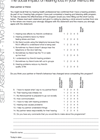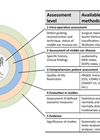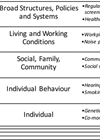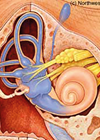Audiology features
Measuring client-centred outcomes in audiology: towards a parsimonious solution
From an international driver to the client-centred care model; in this article Anthony Hogan explores outcome measures for individual goal setting and measuring those outcomes. Introduction When people present for hearing help, they are typically looking for solutions to the...
Health related quality of life measures as outcome parameters in middle ear diseases
Surely the only outcome needed for post-surgical ears is a better PTA? Marcus Neudert argues there should be more to it than that. To draw a comprehensive picture of the disease-associated restrictions in patients with chronic otitis media, audiometric outcome...
The mounting burden of hearing loss worldwide: gearing up global collaboration
As audiology and ENT professionals we all have an inkling about the prevalence and impact of hearing loss, but the true gravity of the situation is even greater than previously thought… It may seem hard to believe, but in the...
The role of public health in addressing age-related hearing loss
Prevention and treatment of hearing loss needs to be viewed through a public health lens, but what does that look like? Kelly Reavis and colleagues explain the steps to addressing hearing healthcare from a public health perspective and why this...
World Health Assembly adopts a resolution on hearing loss: a defining moment for the global hearing health community
The World Health Assembly recently adopted a resolution on hearing loss. In this article Shelly Chadha and Alarcos Cieza outline how the resolution came to be and how the World Health Organization and its partners plan to implement it. The...
Public health planning for hearing impairment (2017)
In 2009 Professor Andrew Smith and Dr Daksha Patel identified the need for awareness of public health methods in hearing healthcare planning. In 2010 the first training course was held, and since then 760 health workers from 41 countries have...
Unanswered questions in adult ototoxicity associated with platinum-based chemotherapy
Do the potential side-effects on hearing and tinnitus need to be a ‘necessary evil’ of platinum-based chemotherapy? How strong is our evidence base when offering advice to patients and fellow clinicians? David Baguley and his team from the University of...
Diabetes and hearing loss: a review
As hearing health professionals we often ask, especially in older patients, if they have diabetes; but what is the link? How is it manifested and should it change current practice? Alec Lapira reviews the changing evidence. Early attempts to establish...
Thyroid dysfunction and Meniere’s disease: is there a relationship?
The set of symptoms described as Meniere’s disease may have several causative factors. Timothy Hain and Patthida Maroongroge look for a relationship in the literature between Meniere’s disease and hypothyroidism. Meniere’s disease (MD) affects around two in 1000 people and...
Human immunodeficiency virus and hearing impairment
With an estimated 36.7 million individuals living with HIV / AIDS and literature reporting that these conditions contribute to hearing loss, it is surprising that more focus and resources are not employed to tackle this major hearing health concern. Yolandé...
The effects of hormonal changes across menstrual cycle on high frequency auditory thresholds
Physiological changes during the menstrual cycle are well documented; do these changes extend to the auditory system? Lalsa Shilpa Perepa and Rewa Indurkar delve into the literature to find the evidence. Menstrual cycle refers to a series of changes that...
OTC hearing aids
The potential for the deregulation of hearing aid technology, through the Over-The-Counter Act has led to a tremendous amount of opinions and views from all stakeholders in the US. You don’t have to go far on the internet, social media...















